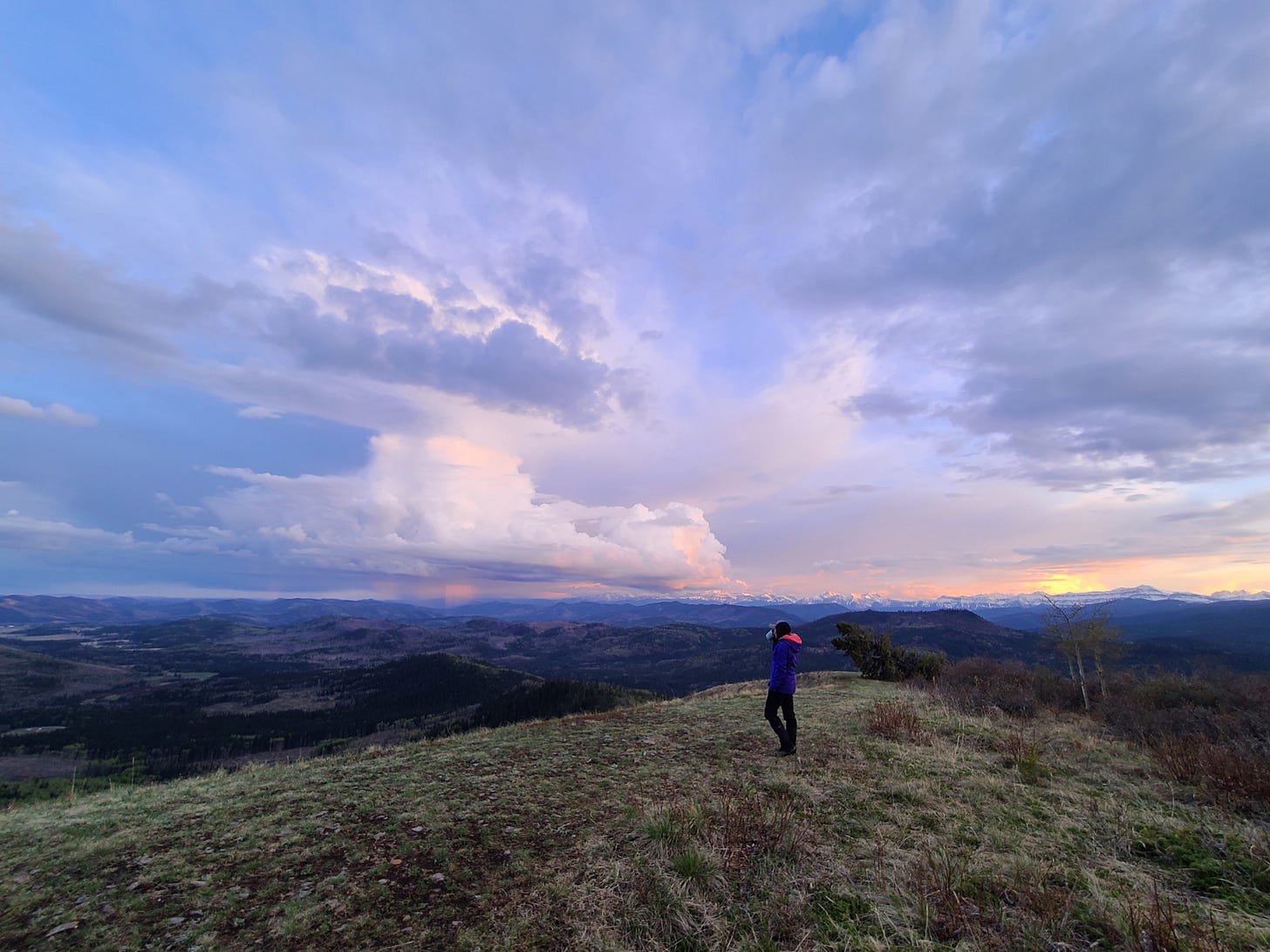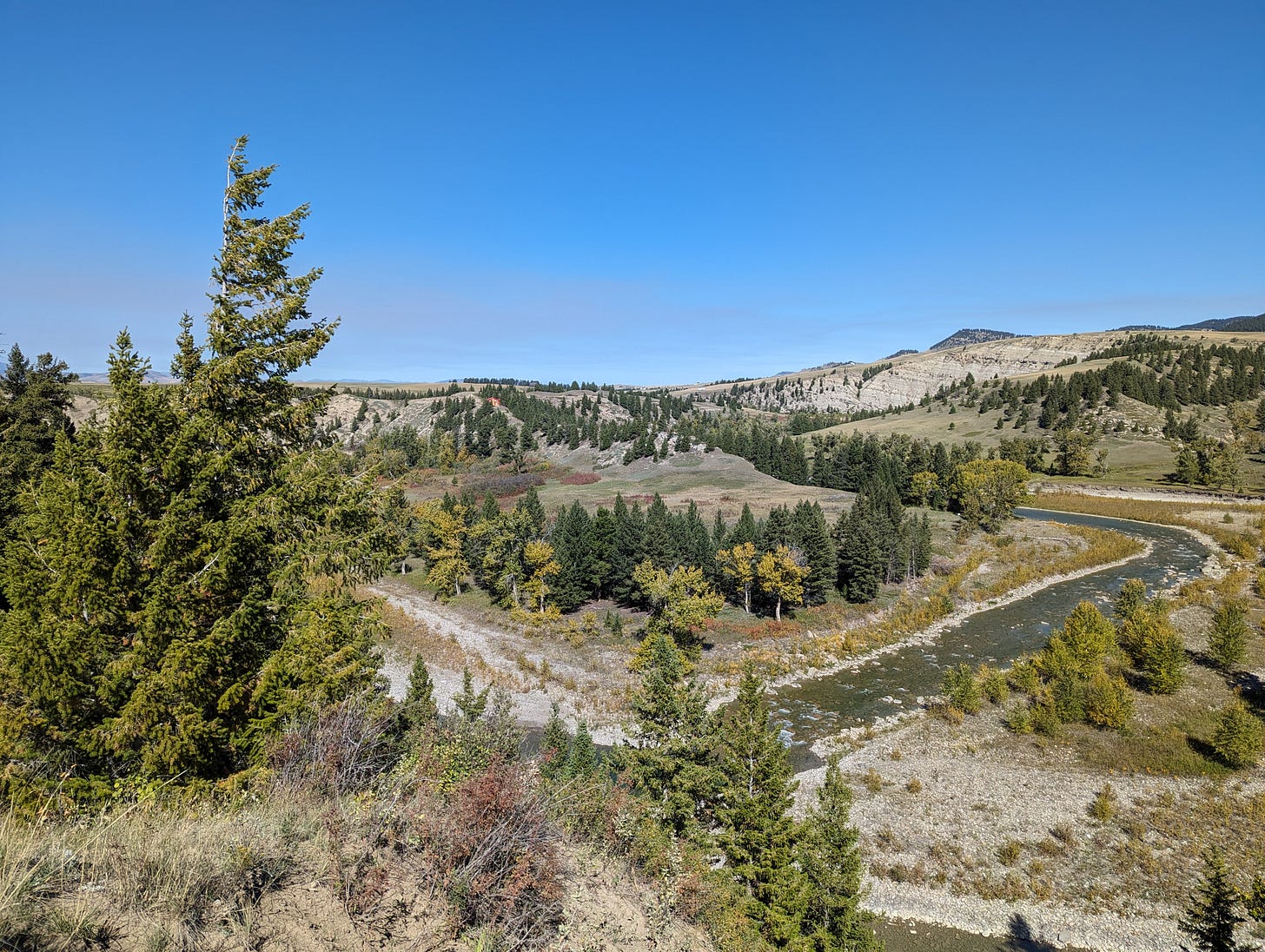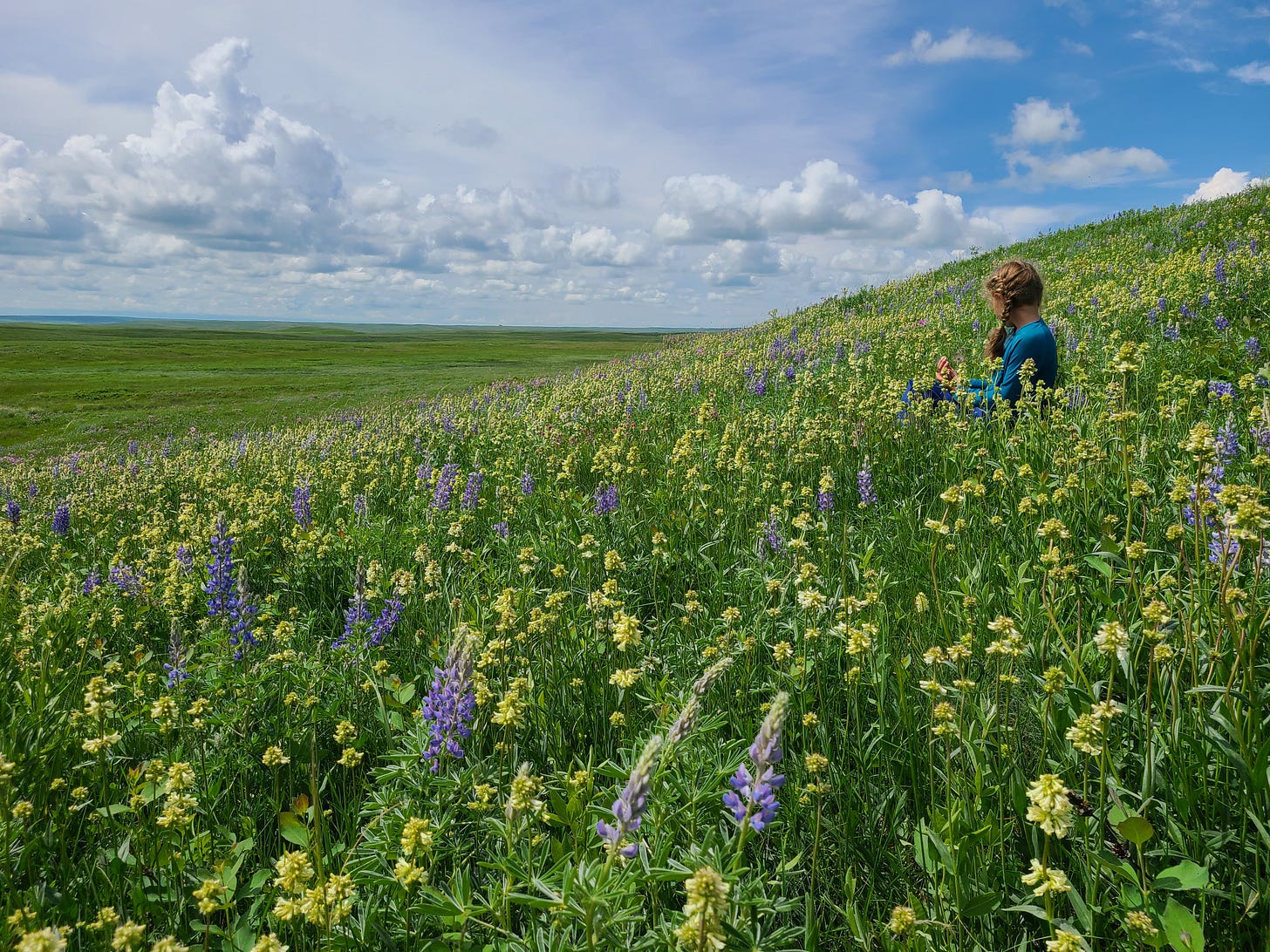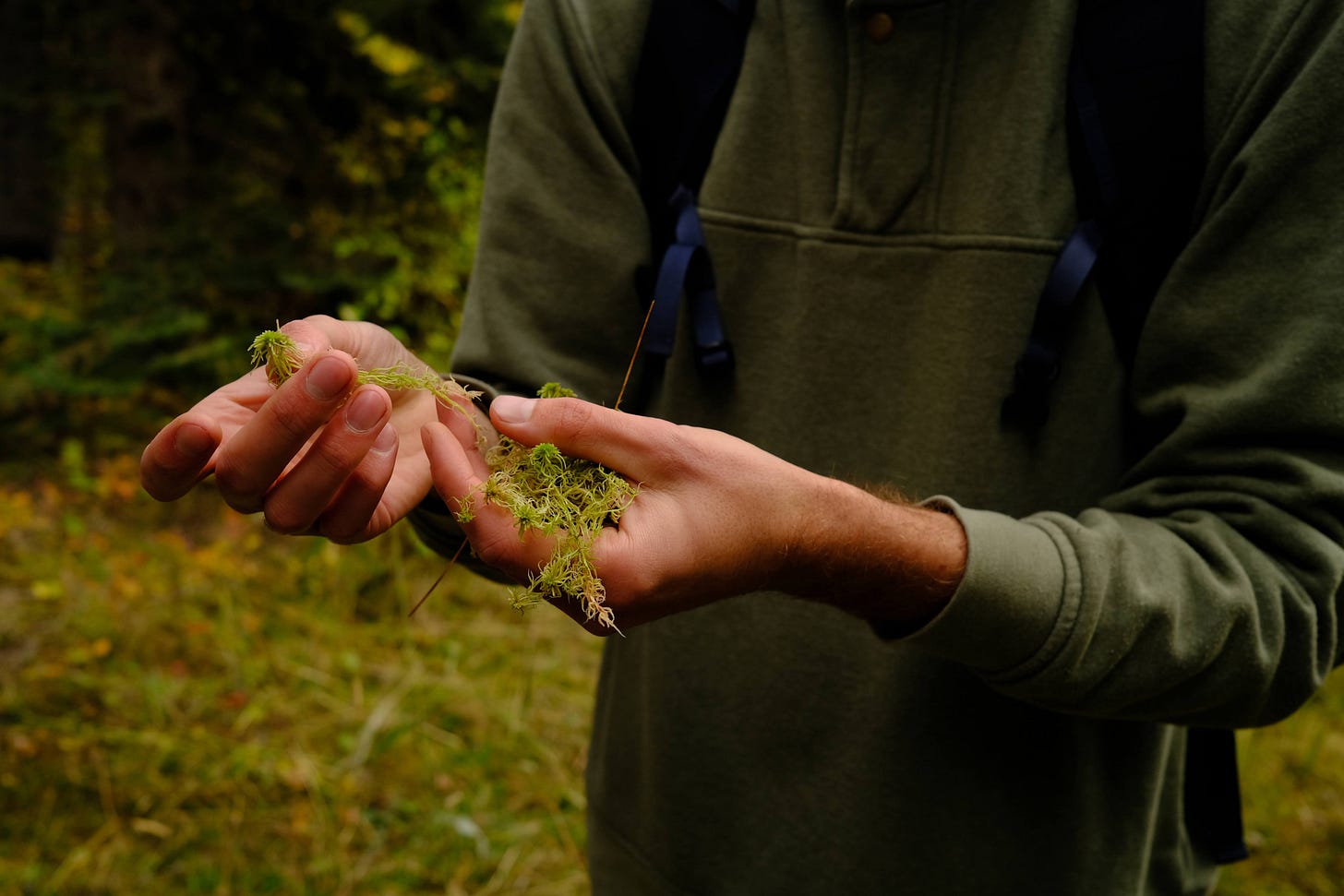Q & A with Lindsey Wallis of 'Adventures for Wilderness'
And why exploring a place in person can ignite a desire to protect it
Go Outside subscribers receive advice, stories, trip reports, interviews, reflections, opinions, and outdoorsy goodness in their inboxes. If you enjoy and value our work, consider becoming a paid subscriber. Contributions from readers like you make this newsletter possible.
Before we get to today’s post, some exciting news. There’s a new member of the Go Outside family! Cailynn had a healthy baby boy in late May. Everyone is doing well and looking forward to future adventures.
An Adventures for Wilderness sunset hike at Mesa Butte, photo by Lindsey Wallis
No matter how long you’ve been going outside, there’s something special about exploring a new-to-you place with someone who knows the landscape well.
Last fall, I (Annalise) explored a part of the Oldman River valley and a ceremonial spot of the ancestral Siksikaitsitapi with author and conservationist Kevin Van Tighem and a group of several other people I met for the first time on the trip. It was a chance to hike around a place I’d never been in southern Alberta with someone who’s been observing changes to this ecosystem for 30 years.
A photo from said hike
The wander made for a memorable and educational day and it was all part of an Alberta Wilderness Association program called Adventures for Wilderness.
These adventures are a by-donation (and often family-friendly) way to go outside with strangers, learn from experts, and leave with lots of knowledge about a new place. We highly recommend you check one out!
From exploring fossils in buildings in and around downtown Calgary, to an 18-kilometre hike of Hussey’s Loop in the Ghost watershed, to a hike and sketch in the Upper Highwood in Kananaskis, where there are plans to clear-cut more than 1,000 hectares of mature forests, this summer’s lineup of Adventures for Wilderness has something for everyone. The adventures are led by coordinators who are experts on the particular area and volunteer their time.
We spoke with Adventures for Wilderness Coordinator Lindsey Wallis about the program. This interview has been edited for length and clarity.
A sea of wildflowers at the Milk River Ridge, photo by Lindsey Wallis
Question: Can you describe, for somehow who’s never heard, what is Adventures for Wilderness?
Answer: “Adventures for Wilderness is the outreach arm of the Alberta Wilderness Association. The idea is to educate people about some of the issues that are affecting our wilderness and also just take them outside so they can be in these places and experience them and feel some connection to them.
When they’re talking to other people, or writing letters to their MLA, they can have that personal connection to these landscapes and that real love for them that makes them really want to protect these places.”
Q: How long has the AWA been doing Adventures for Wilderness?
Answer: “We started the Adventure program in 2020 … it replaced our annual Climb for Wilderness at the Calgary Tower, which was more of a fundraising event. We also used to have a hiking program. We’ve wrapped it all together into this program.”
Q: Tell me about what different sorts of adventures exist. Do you have any favourites?
Answer: “We just did two of my favourites that we do just about every year. One was up to the Milk River Ridge; it’s a really neat one for people to go on because it’s through land that is grazing lease land, so normally to access this land you have to contact the lease holder, which is another step for people that makes it a little bit difficult. If you come with us, we’ve done all that work for you. You’re also with somebody who knows so much and knows that landscape and can tell you all the plants that you’re seeing and all the birds that you’re hearing.
The other one that just happened is up to the Whaleback, which again, is a spectacular place, and we do it every year. It doesn’t have lots of trails that are marked, so by going with someone who knows the area, then you don’t have to worry so much, you can just sit back and enjoy it and let us take care of the logistics.
A couple that are coming up that are really exciting: the Wainwright Dunes on June 16. It’s crazy there are sand dunes in Alberta and again, just going with someone who knows about all of the plants that are growing there, and birds living there, and about how the area was formed and how it became an ecological reserve. That’s a fun one.
Crossing a beaver dam in the Wainwright Dunes, photo by Lindsey Wallis
West Fraser is planning to do a clear-cut up in the headwaters of the Highwood, so on June 22, our conservation specialist Devon Earl and a good friend of mine, Carolyn Fisher, who is an artist and author, will take folks for a little walk and they’ll do a little bit of sketching or journaling to reflect on that place and document it before it disappears. They’ll learn about what is going on with the clear-cuts and why we think it’s a terrible idea and what people can do to perhaps stop it.
A similar one, July 6, we’re going to the Rosebud. Again, it’s another place that’s beautiful. We’ll be walking on private land with some of the landowners who live there, who all have conservation easements because they know the value and the ecological value of their land, and there is a proposal to build a racetrack there. It’s leaning about the things that are happening there and what you can do to protect the area.
We have these ones based around issues, then we also have one at the end of July, that is just a nature walk out at McKinnon Flats, so close to Calgary, pretty chill. There will be some experts there on pollinators, so you’ll be walking along this small area and learning about all the cool plants and pollinators that live there.”
Adventures for Wilderness participants learn about interesting things in the natural environment from experts working in the field, photo by Phillip Meintzer
Q: It can feel like lately everything is a fight. Every month or two, there’s a new natural space we need to fight to protect. The fact you are actually taking people to these places makes it so much more real, hey?
Answer: “You try to balance ‘this is under threat and we have to do something about it,’ but also ‘look at how beautiful it is and let’s enjoy being out here.’
Some places, like the Whaleback we were just at … it’s one of those places that is a real success story. Local landowners, ranchers, conservationists, ordinary people pushed for protection for that area in the 1970s, otherwise it was going to be full of gas wells. Due to public pressure, now it’s a protected park.
People really can make a difference. It’s nice to highlight that things have changed because ordinary people have stood up and written to their MLA and talked about it and signed petitions. It really does make a difference.”
An adventure in the Whaleback, photo by Lindsey Wallis










